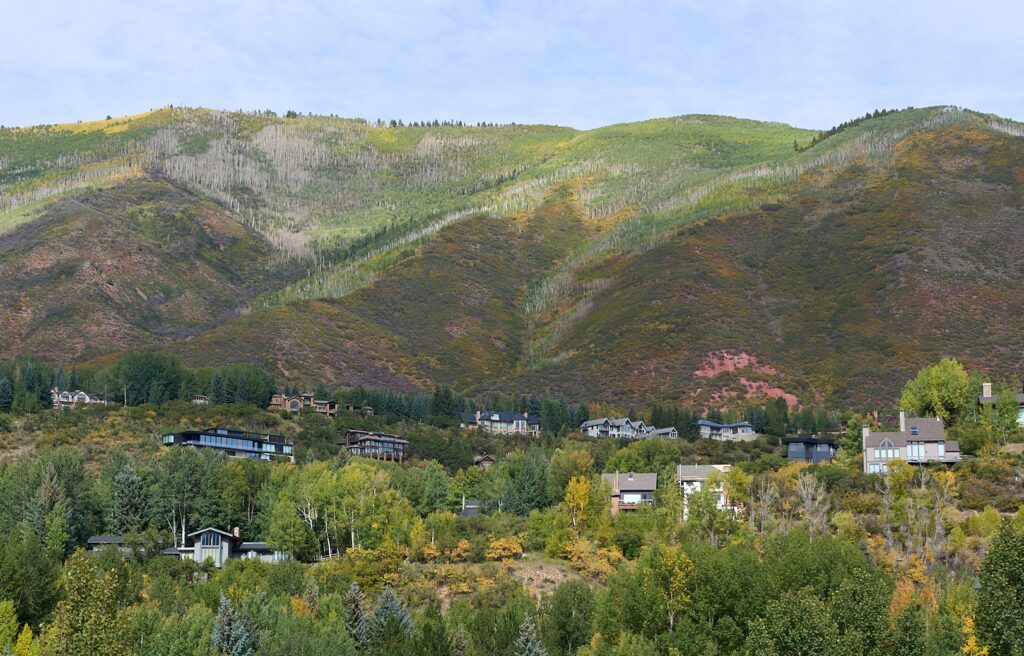Roaring Fork Valley Phenology | July 9, 2015
ACES Staff
July 9, 2015

My standard “need to be back home in two hours” hike is up Hunter Creek around to the trails on Smuggler Mountain and down the road. I do this hike at least once a week and take photos in the same spots each time. My intent is to document the change in the seasons and how the life events of plants and animals are progressing. I think about what I am seeing, smelling, and hearing, and usually jot down notes when I get home.
This practice has enabled my inner hunter-gatherer to be on alert for anything out of the ordinary. Last week, while walking on one of those trails, a slender green spire caught my eye in the aspen/lodgepole understory. I was five feet past it when I stopped, turned around, and knelt down to get a closer look. Wow! A wildflower I had never seen before!
 Slender Spire Orchi Piperia unalascensis |
 Basal leaves |
From the parallel veins on the three basal leaves I could tell it was a monocot, and as I got close to the tiny green flowers, not a half of centimeter wide, I determined it was an orchid. I took photos, so I could identify the orchid later, and bounded down the trail with more pep in my step.
When I got home I identified it as Piperia unalascensis, known as slender spire orchid or Alaska piperia. The species name unalascensis comes from the Aleutian Island, Unalaska which is where the species was likely first discovered. In my research of Colorado orchids I came across this interesting on-line guide. I was amazed to see over twenty species of orchids listed. This punctuated how special and often elusive these flowers can be.
 Three lighter colored sepals can be seen. One in the center/top and two on the sides pointing down and out. Two petals are below the top sepal and the lip is below. The spur is hidden. |
Orchids are one of the most specialized and diverse flower families in the world, with more than 20,000 species of orchids spanning the globe. They are simple in that they often have just a few leaves and a few flowers. But the variety of flowers, scents, and specialized needs for water, sun, nutrients, and air make them anything but simple. Orchids are treasures.
So here I was with what seemed to me as the most plain, colorless, nondescript orchid imaginable, but yet I found my mood boosted by the discovery. It got me thinking that it might be possible to see five orchid species on this hike. I had missed seeing the calypso (aka fairyslipper) orchid by a week or two, and I didn’t find the green bog orchid I saw last year. However I did see the rattlesnake plantain orchid and the coralroot orchid on this hike.
 Spotted Coralroot Orchid emerging and last year’s stalk seedpods. Corallorhiza maculata |
 Rattlesnake Plantain Orchid leaves Goodyera oblongifolia |
Anyone can increase their observational skills if they concentrate on looking for something special. Not only might they find what they are looking for, be it a new flower, an edible mushroom, or a sweet berry, but the “hunter” realizes a bigger payoff: the whole landscape becomes more alive and rich. Pick something specific to find – you won’t believe all of the other things you will see when you start looking.
 When you go out looking for something you often find something else. Aspen Orange Cap Leccinum insigne |
Elsewhere in the Roaring Fork Valley…Flowers are peaking from 9,000 – 10,000 feet. Go see the show! Peak in the high country (10,000 – 11,500 feet) should span the last two weeks of July, and the first two weeks of August.
The first serviceberries are starting to change color.
Some mushrooms, including a few species of boletes that typically fruit in August, have been seen as early as mid-June. It will be interesting to see how long the fruiting season goes given the recent rains.
Sapsuckers, wrens, swallows, and other cavity nesters currently are tending to nestlings. In the next two weeks look out for wayward fledglings. Leave them where they are, give them space, and keep pets away.
~ Jim Kravitz, Director of Naturalist Programs
Related Content

RFV Phenology: Green is out, yellow is in! Or is it?
Learn More
ACES // City of Aspen Open Space Birding: Marolt Open Space 9/5/2024
Learn More